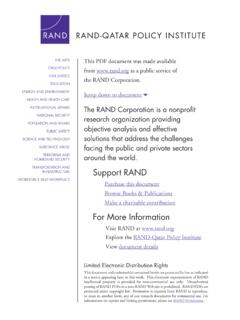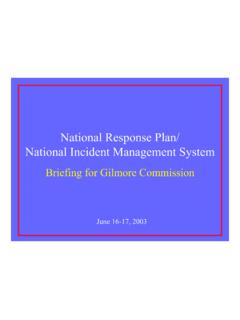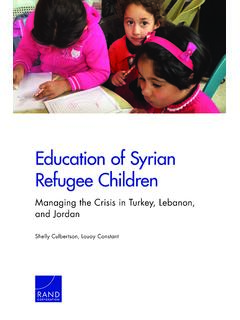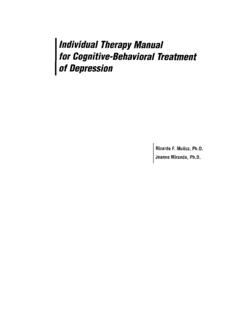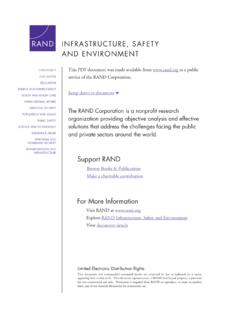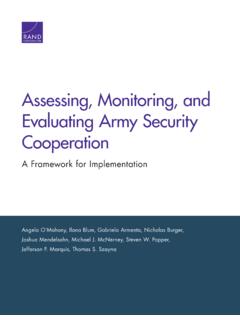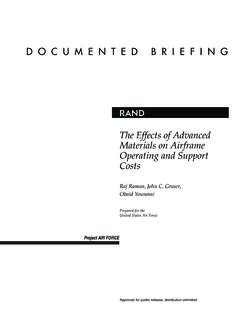Transcription of Globalization's Security Implications - RAND Corporation
1 globalization s Security ImplicationsRAND issue papers explore topics of interest to the policymaking community. Although issue papers are formally reviewed, authorshave substantial latitude to express provocative views without doing full justice to other perspectives. The views and conclusionsexpressed in issue papers are those of the authors and do not necessarily represent those of rand or its research sponsors. Copyright rand Paper RINTRODUCTION globalization is a multidimensional phenomenon:Information technologies, along with a variety of othertechnologies, are developing rapidly and spreading is expanding globally, as is the flow of private capi-tal and investment. Interdependencies are growing in allaspects of our lives. These developments create real possi-bilities to achieve economic prosperity, spread politicalfreedom, and promote peace. Yet they are also producingpowerful forces of social fragmentation, creating criticalvulnerabilities, and sowing the seeds of violence and con-flict.
2 Economic crises extend across state borders and areproducing global hardships. All of these are aspects ofwhat is commonly referred to as globalization , and allhave important Security dangerously, a variety of threats have becomeglobal in scope and more serious in their effects as a resultof the spread of knowledge, the dispersion of advancedtechnologies, and the movements of people. These samedevelopments, combined with expanding global economicinteractions, contribute to some of the problems andresentments that lie at the root of these Security threats. Butparadoxically, many of those same aspects of globalizationoffer new opportunities to achieve economic growth anddemocracy, thereby ameliorating the threats as well assome of their underlying dangers were clearly manifested in the September11th terrorist attacks, which showed how the Al Qaedaorganization was able effectively to exploit new communi-cations technologies, global financial networks, and theease of movements of people.
3 The response by the interna-tional community has also benefited from some of global-ization s effects, primarily in technological advances incommunications and in military weaponry. While it is toosoon to say definitively, the result of these attacks may beto dampen some of the globalizing trends, as financialinteractions receive greater scrutiny and Security stepslimit the mobility of people. Exploring the many issuesraised by the September 11th terrorist attacks is not thispaper s task, nor is assessing the relationship between ter-rorism and globalization . Instead, the paper raises the broader issues arisingfrom different aspects of globalization , focusing both onthe threats and the opportunities, with the goal of suggest-ing very briefly a new way of approaching Security in thecoming decades. Just as important, the paper tries to makethe case that the national Security and international eco-nomic policymaking communities each has a critical stakein what traditionally have been the responsibilities of theother.
4 TRANSNATIONAL THREATS Many different aspects of globalization now combineto increase the dangers of a variety of transnational threatsLynn E. Davis1 See Robert O. Keohane and Joseph S. Nye, Jr., Introduction, inJoseph S. Nye and John D. Donahue, editors, Governance in a GlobalizingWorld, Washington, : Brookings Institution Press, 2000; RobertGilpin, The Challenge of Global Capitalism, Princeton, : PrincetonUniversity Press, 2000; David Held, Anthony McGrew, David Goldblatt,and Jonathan Perraton, Global Transformations Politics, Economics andCulture, Stanford, Calif.: Stanford University Press, weapons proliferation, cyber attacks, ethnic violence,global crime, drug trafficking, environmental degradation,and the spread of infectious diseases. What kinds of strate-gies and actions might they require?2 Proliferation of Dangerous WeaponsThe potentially destructive capabilities of weapons ofmass destruction (WMD) in the hands of enemy states andterrorists clearly suggest the need for a preventive National Strategy to Combat Weapons of Mass Destruction,issued in December 2002, defines three pillars: counter-proliferation to combat WMD use, strengthened nonproliferation to combat WMD proliferation, and consequence management to respond to WMD use.
5 3 The strategy s first, counterproliferation pillar calls forthree types of action: interdiction, deterrence, and defense,and reserves the right to respond with overwhelmingforces including through resort to all of our options tothe use of WMD against the United States. It is here thatthe strategy also includes the requirement for the capa-bility to defend against WMD-armed adversaries, includ-ing in appropriate cases through preemptive measures. 4 The strategy s second, nonproliferation pillar involvesthese elements: diplomacy, multilateral regimes, threatreduction programs, and controls on exports and the relative attention that is being given to thecounterproliferation activities, one senses an underlyinglack of confidence in the nonproliferation pillar. Little isbeing done to bolster the multilateral nonproliferationexport control regimes, and the administration has sup-ported legislation to liberalize rather than to controlexports. It has rejected efforts to improve the verificationprovisions of the Biological Weapons Convention, arguingfirst that verification was not feasible given advances intechnology and then that the transparency requirementscompromised proprietary commercial interests.
6 Theadministration s alternative suggestions for internationaland domestic legal constraints remain vague. Officialshave called for action against states sheltering terrorists,proliferators, and suspect shipments. But so far they havebeen content with simply exposing violators of interna-tional arms control treaties and making the case forremoving Saddam preparations to pre-empt suspicious activities; defend against missile attacks;and destroy nuclear, biological, and chemical capabilitiesin rogue states are in fact a strategy for a world where dangerous weapons will be global spread of ideas and technologies is unques-tionably making it easier for states, and even disaffectedgroups, to develop the most-dangerous weapons. So it isfair to question whether a strategy can be designed thatcan offer any real prospect of preventing weapon prolifer-ation. But before coming to a judgment, what is required isa serious analytic effort to discover how and with whatconfidence access to the critical knowledge, materials, andtechnologies can be denied to those bent on acquiringweapons of mass answer this question, one would focus on the fol-lowing nonproliferation tools: domestic and internationalsecurity mechanisms for storage and transfers, multilateralexport controls, arms control verification and enforcementmeasures, intelligence surveillance and tracking opera-tions, and military and other forms of interdiction.
7 Each ofthese would need to be evaluated, individually and thenin combination, in light of technological , these tools would need to be considered in terms ofreal-world situations in individual countries, many ofwhich already have nascent WMD programs, as well asfor non-state groups. In the case of export controls, forexample, the individual items on the multilateral lists cur-rently governing the transfer of critical weapons relateditems and technologies need to be assessed in terms oftheir availability and how widely they have alreadyspread. In other words, the issue is whether they can actu-ally be the potential contributions of each ofthese nonproliferation tools would set the stage for anassessment of whether any combination of actions offers areasonable prospect of success. Among the steps thatwould improve the current strategy would be for mem-bers of the current multilateral nonproliferation regimes, , the United States and other major industrial countries,to require prior notice for transfers of any of the critical2 The threats arising from drug trafficking and global crime are notaddressed in this paper because preventive strategies are being pursuedand reasonably effective collective decisionmaking processes exist.
8 ForRAND research on these topics, see Strategy to Combat Weapons of Mass Destruction, December 2002, , p. , p. , pp. 3 the speech by John Bolton, Beyond the Axis of Evil:Additional Threats from Weapons of Mass Destruction, HeritageFoundation, Washington, , May 6, and technologies, introduce intrusive compliancemeasures in the WMD arms control treaties, impose politi-cal and economic sanctions for misbehavior, put in placereal-time surveillance and information sharing on com-mercial trade, and act to interdict suspicious commercewith quick-reaction forces. With this background analysis, governments wouldthen need to decide whether the prospective gains in pre-venting the spread of dangerous weapons would be worththe potentially high price they would have to pay in lossesof commercial sales, expected political costs to enforcesanctions for misbehavior, and military risks in interdict-ing suspicious activities that a credible nonproliferationstrategy would likely entail.
9 To be effective, these mea-sures would have to be adopted by those countries thattoday control the critical weapons-related items and technologies. In the end, such an analysis may indicate that no com-bination of actions can promise success in preventing thespread of dangerous weapons, or that these actions are toodifficult or costly. To assume that this is the case in theabsence of analysis is risky, however, because if furthersteps are not taken, it is more likely that the result will be aworld in which states and terrorists will develop andpotentially use these weapons. Other Transnational ThreatsInformation technologies and systems are central features of globalization and have become increasinglyimportant to the functioning of many critical civilian sys-tems communications, energy, transportation, electrical,water, and banking. The problem is that they now arepotentially vulnerable to the threat of cyber attacks anddisruption. The dangers arising from environmentaldegradation often cross state borders.
10 The most publicizeddanger involves the rising global temperatures that aretouching off devastating droughts, floods, and violentstorms. Other environmental dangers include air andwater pollution, the loss of forests and biodiversity, andthe potential introduction of toxic substances into thehuman food threat is growing that infectious diseases willspread globally and quickly, as a result of increasinglydrug-resistant microbes, the lag in development of newantibiotics, poor patterns of land and water use, shifts inclimate, the rise of mega-cities with severe health caredeficiencies, the ease of movement of peoples across bor-ders, and the growing number of refugees. intelli-gence estimates project only limited gains over the coming20 years against the overall infectious-disease threat, withvirulent diseases, led by HIV/AIDS and tuberculosis, continuing to take a significant motivated by ethnic and religious hatreds iscertainly not a new phenomenon. Today, however, it isoften associated with the shedding of traditional economicstructures in the wake of expanding global commerce andmajor disruptions in existing patterns of political authoritycaused by the spread of information technologies.

